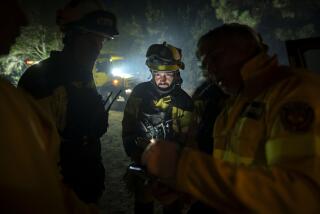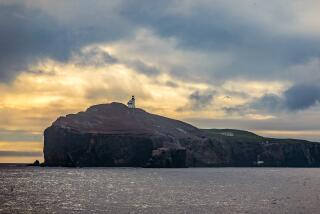Canary Islands Send Love Letters in Sand
- Share via
LA LAGUNA, Canary Islands — You could describe it as two kilometers of “love letters in the sand” or a flattened-out Pasadena Rose Parade, but whatever you call it, the Corpus Christi Day festival of sand and flower paintings on the streets is like nothing you’ve ever seen.
On a sunny spring holiday morning, while old men in black berets stand in dark, wood-paneled bars smoking and talking, civic leaders, housewives and teen-agers in sweat shirts and jogging shoes work rapidly to complete their fragile masterpieces.
They arrange roses in kaleidoscopic patterns against a background of black volcanic sand, then sprinkle borders of green grass around it. Passers-by kibitz and sometimes lend a hand.
Every year on the feast day of Corpus Christi (this year May 25) the people of La Laguna, Puerto de la Cruz, La Orotava and other towns on the island of Tenerife gather in groups.
Organizations Compete
School clubs, church organizations, civic fraternities and even an ad-hoc assortment of citizens who want to make a flower carpet prepare these exquisitely detailed displays on religious or patriotic themes on the streets of the old town.
Any material that comes to hand is used as long as it matches the color they are trying to get, from whole fresh flowers (mostly roses with the dew still on) to acorns, corncobs, fragrant dried grasses, dried beans and peas, crushed rock, white rock salt or volcanic sand in shades of red, black or gray.
In honor of the holiday, handsome old tapestry banners hang from the windows of the historic town hall. The city, oldest on the island, will celebrate its 500th birthday in 1996, and city fathers are hoping that officials back on the Spanish mainland will declare it a national historic monument for the occasion.
Inside their city hall they proudly show visitors the elegant carved-wood ceiling, suits of armor, antique chests and an ancient grant deed on sheepskin from Dona Juana, daughter of Queen Isabella. (Isabella’s protege, Christopher Columbus, stopped off in the islands on his way to discover America in 1492.)
Reminds of Turkey
Unpainted Canary pinewood balconies reminiscent of the Turkish balconies of Asia Minor overhang the side streets of La Laguna. Bakery windows are piled with sugar-dusted pastries and gofio (toasted cornmeal or wheat) cookies; gardens are bright with flowers.
In one garden, roses, fuchsias, bird of paradise and impatiens--four unlikely bedfellows--all bloom together in the rich volcanic soil.
Strawberries grow all year in the perpetual springtime, along with tiny sweet tomatoes and 10 varieties of potatoes. Grapes, avocados, papayas and bananas grow on the hillsides and coppery orange nasturtiums climb up and down the ravines.
Red and pink geraniums and purple statice flourish like wildflowers, along with native shrubs such as echium, the spiky purple-flowering plant often called Pride of Madeira or Pride of Tenerife, and dracaena, “dragon trees,” which grow to prodigious size here. There’s a 3,000-year-old specimen in the village of Icod de los Vinos.
Inland is snowcapped Mt. Teide, at 12,195 feet the highest mountain in all of Spain, wreathed in clouds most of the time.
Take Weeks to Build
Only the colorful sands from Teide go into the largest and most famous of the sand tapestries, those of the hillside village of La Orotava.
The three central paintings for 1988, which took six weeks to build and used 5,500 pounds of volcanic sand, depicted the Annunciation, the Assumption of Mary and the Worship of the Wise Men.
On the day of the San Isidro romeria (procession) eight days after Corpus Christi, flower carpets are built around them as frames. The procession honors St. Isidore, who was a farm worker, and the participants dress in peasant costumes and ride in bullock carts.
The 200-year-old botanical gardens, which lie downhill from La Orotava near Puerto de la Cruz, are considered among the most important in Europe and carry a three-star rating in the green Guide Michelin.
African tulip trees and calla lilies bloom everywhere, and a huge 200-year-old rubber plant (ficus) perches atop its stiltlike hanging roots like a predatory creature from outer space.
The islands are thought by geologists to be 15 million years old, although some scholars have suggested that the chain is a likely candidate for the lost continent of Atlantis because the indigenous settlers, the now-extinct Stone Age tribesmen called Guanches, knew nothing of navigation or boat-building although they were surrounded by water.
Extinct Tribes a Mystery
Others say the tall, blond and blue-eyed Guanches were a mix of Viking, Phoenician and Berber blood, or, because they mummified their dead, might have originated in Egypt. (See Guanche artifacts and mummies in the Archeological Museum in Santa Cruz de Tenerife.)
The European tourist market has long since discovered this string of warm, sunny volcanic islands off the west coast of Africa.
British, Germans and Scandinavians flock here in great numbers during winter, mostly on low-priced package tours and charter flights.
Few of them, however, venture from the popular resort areas on the coast and the duty-free shopping to explore inland villages and culture.
Despite its rocky coast, wild surf and total lack of beach front, Puerto de la Cruz on the lush green northern side of the island is the major tourist resort of Tenerife.
Artist Cesar Manrique and enterprising entrepreneurs have carved out a series of artificial saltwater pools and lagoons from volcanic rock to make an eight-acre beach park called Lago de Martianez.
The park is prettily landscaped, broken up by volcanic rock formations, sandy coves for sunbathing, palm-dotted islets, spurting fountains, sunbathing pavilions and an underwater disco that stays open as late as eight in the morning.
Oriented to Tourists
Puerto de la Cruz has its mind fixed firmly on tourism, from the rows of T-shirt stores to multilingual fast-food outlets vending baked beans, bratwurst, pizza and hamburquesas.
Loro Parque is a local version of Sea World, with dolphin shows and the largest collection of parrots in the world, including one that whistles the triumphal march from “Aida.”
But where are the canaries? According to the directors of the parrot park there are plenty of little wild yellow finches (the ones we call canaries) back in the mountains. But they were named for the islands rather than vice versa.
The Romans called the islands Insula Canum after the wild dogs they encountered. Only later, probably spurred by a medieval director of tourism, did the islands change their name to the more euphonic Islas Canarias.
-- -- --
Iberia Airlines flies to the Canary Islands nonstop from New York City and to Madrid nonstop from Los Angeles, with frequent connections to the islands.
The three top hotels in Puerto de la Cruz, the Botanico, San Felipe and Semiramis, are rated five-star by the government and cost about $100 U.S. for two, with breakfast and taxes included.
For more information on travel to the Canary Islands, contact the National Tourist Office of Spain, 8383 Wilshire Blvd., Suite 960, Beverly Hills 90211, (213) 658-7188.
More to Read
Sign up for The Wild
We’ll help you find the best places to hike, bike and run, as well as the perfect silent spots for meditation and yoga.
You may occasionally receive promotional content from the Los Angeles Times.






